Types of Crap Bets – Choose the Craps Strategy That Works for You
Many people believe that craps is quite a challenging game and even assume they cannot learn to play it. However, this concept is wrong, and craps rules are straightforward – the players place wagers on the results that come out after throwing two dice. What can confuse you and make the game somewhat challenging is the multiple craps bets available.
Most bets in craps are quite easy to understand, but the main difficulty comes from their significant number, which makes the game a bit complicated and inexperienced players often get confused and cannot distinguish the best craps bets.
Happily, it is not significant players to be closely familiar with all wagers to play craps – it is enough to understand the pass line and don’t pass line bets, the odds bets and the come and don’t come wagers. Below you will find detailed information about these essential bets, description of other types of craps bets, and valuable data about the best bets in craps. Thus, you will be able to come up with a craps betting strategy that works for you.
Pass Line and Don’t Pass Bets
These bets are not only the easiest to understand but also the two most common wagers. Typically, shooters have to place one of these two wagers before they make the come-out roll. Some casinos also require players to make the pass line or don’t pass bet before they place any other bets.
The main rules about these two chances are that players need to put them right before the come-out roll and that the two wagers pay 1:1 when they are winning, which means that the bets pay even cash.
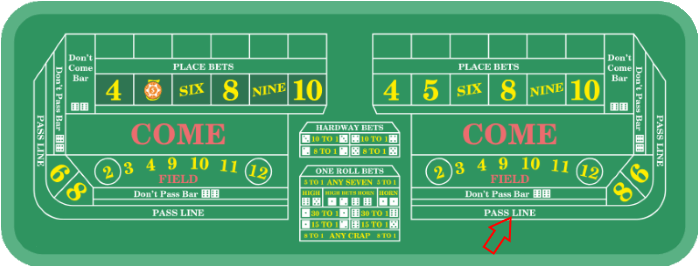
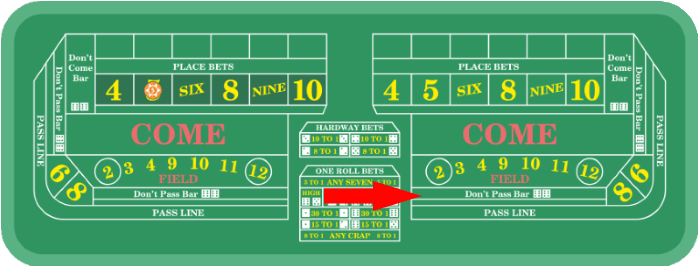
In case the come-out roll comes in seven or eleven, then the pass line wager is successful. The bet is unsuccessful if the outcome is two, three or twelve. When any other number comes out as a result of the roll, it establishes the so-called “point, ” and the bet remains valid until the player turns the point or goes seven. In the first case, i.e. when the point comes out of the roll, the bet registers a win. However, if the player throws 7, then the bet loses.
The don’t pass win will bring a win to the punter when the come-out throw results in two or three. It will lose if the player throws seven or eleven. Throwing 12, the wager neither wins nor loses, and it becomes pushed. If any other value comes out of the roll, this value becomes the point. In case the shooter hits the point again, the bet releases a loss, but the wager is winning if the shooter rolls seven.
Come and Don’t Come Wagers
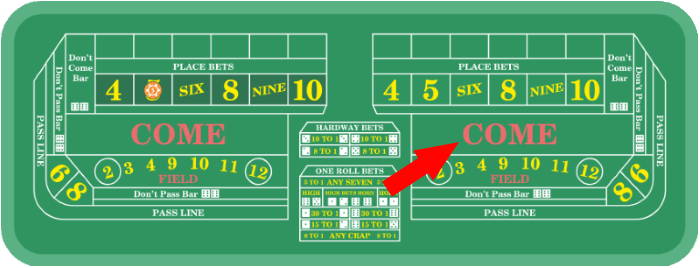
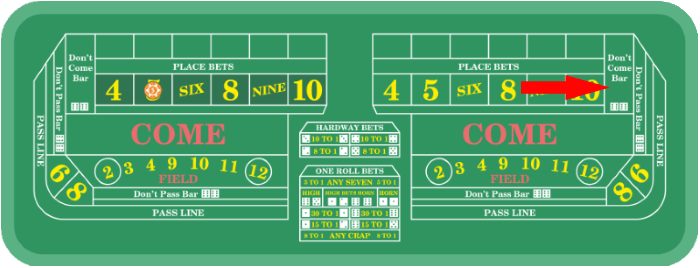
These two wagers are very much like the pass and don’t pass ones with the single difference that the players should place them after establishing the point instead of before that. The concept behind the come and don’t come craps bets may be a bit confusing, so we will discuss it in details to help you understand them thoroughly.
A come bet will win if the shooter rolls seven or eleven, and it will lose if the shooter throws two, three or twelve. In case the player throws any other number of the dice, it becomes the point for the come bet. Thus, if the dice roll five, then five is the point. The shooter throws again, and the wager is still valid. The bet wins if the shooter rolls five again and loses in case the result of the throw is 7.
The other way round, the don’t pass wager does not succeed if the shooter hits seven or eleven on their first roll after the placing of the stake. The bet succeeds if the dice run two or three. Any other number fixes the point and the stakes continue to be valid until the shooter rolls the point and your bet loses or they throw seven and your bet wins.
The come and don’t come wagers give even cash when they become winning, meaning that the ratio is 1:1.
Odds Craps Bets
Now that you are familiar with the four most essential bets in the dice game, we will describe the other types of wagers, so that you will be able to establish your craps betting strategy. Odds wagers resemble side bets, and players make them after the establishment of a point in each game. There are four types of odds wagers which are extensions of the four bets we described above: pass line odds, don’t pass odds, come odds and don’t come odds.
The pass line odds enhance your pass line bet after the establishment of a point. It loses if the shooter throws seven and wins if they roll the point before rolling seven. The key benefit of the pass line odds wager is that you win, you get your payment at true odds, which means that there is hardly any house edge. The payouts are different depending on the point. Thus, if the point is four or ten, the ratio is 2:1. If the point is five or nine, the payouts are 3:2, and in case the shooter throws six or eight, the payouts are 6:5. According to the rules of craps, you should announce that you are “taking the odds” when you decide to make a pass line odds wager. There is a limit as to the stake because there is no house edge in this case. Players can stake up to three times the total sum of their initial pass line bet, but some casinos allow larger amounts to stake.
The don’t pass odds wager boosts the don’t pass bet, and it wins if the dice run seven before throwing the point. The bet is unsuccessful if the shooter runs the point before rolling seven. The winning bet pays out at true odds, and there is no house edge here, too. Here are different payouts according to the point that the shooter rolls: in case the player throws four or ten, the payment is 1:2; if the point is five or nine, the payouts are 2:3; if the shooter rolls six or eight, the ratio is 5:6. The rules about craps bets define that you need to announce that you are “laying the odds” in case you are willing to put a don’t pass odds wager. There is a limit as to the amount of the stake due to the lack of a house edge.
Big 6 and Big 8
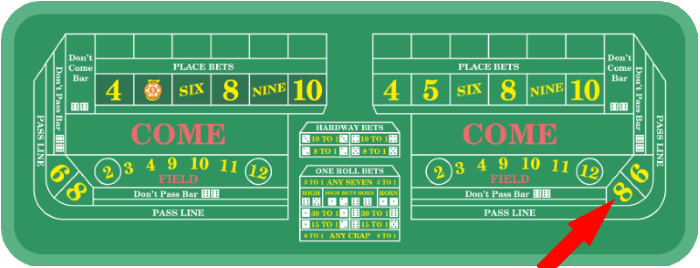
These two craps bets are easy to understand – the big six chance becomes winning if the shooter throws six before rolling seven; the big eight wager wins in case the shooter goes eight before throwing seven. Both bets pay out 1:1, meaning that the payouts are even if they win.
Place Win and Place Lose Bets
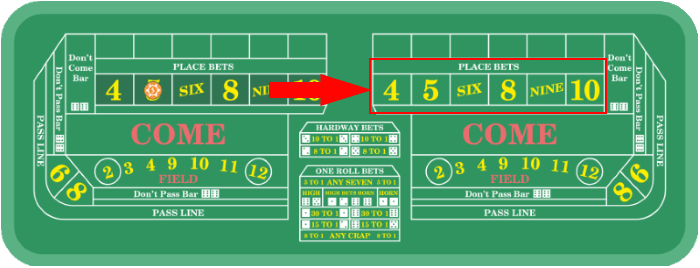
Gamblers can make place win wagers after the come-out throw and after the establishment of the point. The player can put a bet on the numbers four, five, six, eight, ten or nine. The wager wins if the number you have selected comes out before seven. Again, the payout ratios depend on the particular number. Thus, if you have selected six or eight, the ratio is 7:6; in case you have betted on five or nine, the payouts are 7:5; if your number is four or ten, the ratio is 9:5.
The place lose wagers are exactly the opposite of the place win ones. You can bet on the same set of numbers (four, five, six, eight, nine or ten) but here the wager wins if the shooter throws seven before rolling the number you have selected. Once again, the payouts distribution depends on the specific number: six or eight get 4:5 payouts; if you have picked five or nine, the ratio is 5:9; and in case the number is four or ten, the payouts are 5:11.
Field Wagers

The field wagers are placed on the following roll of the dice. The bet succeeds if the shooter hits two, three, four, nine, ten, eleven or twelve and pays double in case of two or twelve and even money for all other numbers. The wager loses if the shooter throws five, six, seven or eight.
Buy and Lay Wagers
Buy bets resemble place win wagers because the player bets that the shooter will roll a given number before throwing seven. The variation is that here the payouts are larger, but players have to pay a commission amounting to 5%. The policy regarding the fee varies, and some casinos require the player to pay it upon placing the wager while other betting providers get it from you only in case your bet wins. The amount of the payout depends on the number the player has selected. Thus, in case you bet on six or eight, the payment is 6:5; if you choose five or nine, the ratio is 3:2, and picking four or ten will give you a payout at 2:1.
In essence, the lay wager is just opposite to the buy bet, meaning that players place a bet that the shooter will throw seven before rolling a given number. Again, there is a commission of five per cent. The payouts are higher compared to the place lose wager, and the ratios are the following: 5:6 for six and eight; 2:3 for five and nine; 1:2 for four and ten.
Hardways
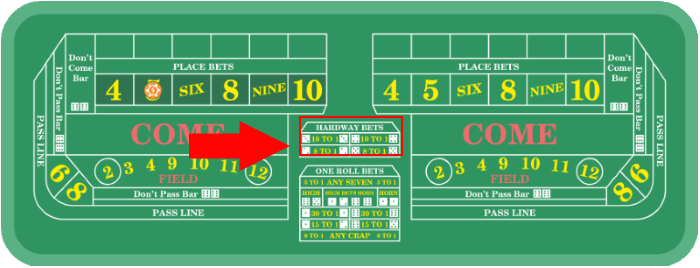
Adopting a successful craps betting strategy requires knowing all possible odds and all rules. If the shooter throws a number as a double to two values, then we say that they have thrown the number the hard way. Thus, a hard six is a double three. The hard way wagers get their name from this rule. These bets allow players to place a wager on rolling a hard four, a hard six, a hard six or a hard ten before seven to win. Again, the payouts depend on the particular number you have selected – the ratio for four and ten is 7:1, while the payout for six and eight is 9:1.
Proposition Wagers
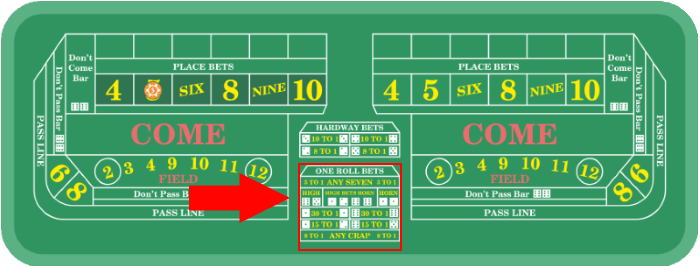
There are several different types of proposition bets. These craps bets offer bigger payouts than the other wagers, but the house edge is higher, too. Experts recommend avoiding them due to the increased risk involved, but you can still practice these bets if you are eager to take the chance. Here are the various proposition bets that are all settled on the following roll:
- Any craps (7:1) – the bet wins if the shooter throws two, three or twelve;
- Any 7 (4:1) – the wager is successful if the dice roll seven;
- Any 11 (15:1) – the bet wins if the shooter rolls eleven;
- Ace Deuce (15:1) – the bet is successful in case the dice throws three;
- Boxcar (30:1) – the wager wins if the dice rolls twelve;
- Aces (30:1) – the bet wins if the shooter throws two.
Best Craps Bets
The primary aim of betting providers is to take the money of clients, and your main purpose is to prevent this by placing good wagers. To help you achieve success, we will list some of the best bets in craps. Thus, understanding the best craps bets, you will be able to develop a winning craps betting strategy and avoid losing cash.
Placing pass line wager is not the wisest thing you can do, but the situation is much different if you put odds behind the pass, come, don’t pass and don’t come wagers. Why is that? The main reason is that the odds reduce the house edge and thus boosts your winnings or limit your losses if the bet is unsuccessful.
Our list of the best bets in craps continues with the place wagers on six or eight. If you place a bet to win, the house edge amounts 1.52 percent and placing the wager to win has a house edge of 1.82 percent. The house edge is quite reasonable in these two cases.
Another addition to the best craps bets selection is the lay wager against four or ten. In this instance, the house edge equals 2.44 percent, which is a bit higher than other bets but it is still entirely manageable and can bring success.
Fields wagers typically payout 2:1, but they can rank among the best bets in craps when casinos provide triple payment. When betting providers have such an offer, the house edge is as low as 2.78 percent, and the wager becomes quite intriguing. It is advisable to place fields wager only in case the casino provides a triple payment.
Now that you are familiar with the various types of craps bets alongside with the best bets in craps, you can develop your craps betting strategy and place successful bets.
Frequently Asked Questions about Types of Crap Bets
-
Why Do I Have to Choose between Pass and Don't Pass Bets before Any Other Bet?Often, the pass or don't pass bets are considered to be the opening wagers in the game of craps, although they're not the only ones. Regardless of which one of them you will choose, a point will be established so that the game can continue in its subsequent gameplay stages. On the other hand, you're not limited to the pass and don't pass options in fact, you can always place a field bet first, which will win if the sum of the dice produces a 2, 3, 4, 9, 10, 11, or a 12, and lose if any other number has been thrown. Bear in mind that if you want to be the shooter, you must place a bet on either pass or don't pass since a field bet does not constitute the establishment of a come-out roll.
-
Is It a Good Idea to Place Big Single Bets?Although that is a subject of personal preference, game experts always suggest that players (especially beginners) stick to playing with the lowest allowed chip denominations, especially on even money bets. After going through a number of plays, you might consider increasing your stake, depending on your personal experience and expectations for the game. Just make sure that you don't start betting big right away!
-
Why Do the Majority of Players Frown upon Others Who Place a Don't Come Bet?If multiple players play a craps game, there is a good chance that nearly all of them will place a Come bet. Let's say, for example, that you would like to put your money on the Don't Come field – which essentially means that you're playing against them and the shooter, as the gameplay condition (rolling a 7 before the establishment of a come-out number) will grant you a win, means that all Come bets will lose.
-
Is There an Accepted Way of Placing a Bet on the Table?There are quite a few rules regarding craps table etiquette. Naturally, most of them won't apply to any online casinos, as you essentially do it with either a click of a mouse button or a tap on a mobile device screen however, there are established standards and protocols in land-based casinos that must be followed to a tee. Should you feel uncertain about the way of placing a bet on a table, you are allowed to ask for assistance from the dealer. One thing you shouldn't do when placing a bet, is to throw your chips at the casino staff that manages the craps game table.
-
Should I Place My Bets on the Left or Right Side of the Table Layout?This will be determined by your own personal preference. Both the left and right sides of the layout represent the same thing, and it is designed in such a way so it can better accommodate the comfort of the player when making a bet. Usually, when you ask the dealer to place a bet for you, they will do so on the side which is closest to you.
